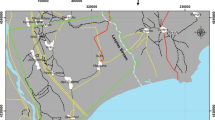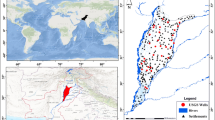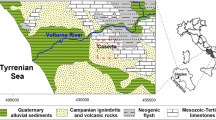Abstract
The Dalyan Region that drains into a complex lagoon system is located on the Mediterranean Sea coast of southwest Turkey. There are no large streams in the area, indicating that a considerable amount of freshwater draining into the lagoon is expected to be based on groundwater inflows and that groundwater quality is an important issue for the lagoon ecosystem. Since the lagoon and its watershed are within an environmental special protection area, planning preventive and mitigative measures toward water quantity and quality, including groundwater, is crucial. Since an important step in such a study is the generation of vulnerability map of groundwater pollution, this study aims at the generation of an intrinsic groundwater vulnerability map and its assessment for the first time in the study area based on the DRASTIC method. Since the DRASTIC method requires recharge rates for the calculation of groundwater pollution potential index, these were obtained from a previous modeling study conducted in the same area, where SWAT model was used. The intrinsic vulnerability maps generated were overlaid with current land-use maps to evaluate actual groundwater pollution risk. Our analyses showed that 46% of the study area is under the high risk of groundwater pollution, where 62% of the vulnerable high-risk area is agricultural land.







Similar content being viewed by others
References
Akhavan S, Mousavi S-F, Abedi-Koupai J, Abbaspour K (2011) Conditioning DRASTIC model to simulate nitrate pollution case study: Hamadan–Bahar plain. Environ Earth Sci 63:1155–1167. doi:10.1007/s12665-010-0790-1
Aller L, Bennett T, Lehr JH, Petty RJ, Hackett G (1987) DRASTIC: a standardized system for evaluating groundwater pollution potential using hydrogeologic settings. US Environmental Protection Agency, Oklahoma, USA
Arnold JG, Srinivasan R, Muttiah RS, Williams JR (1998) Large area hydrologic modeling and assessment—Part 1: model development. J Am Water Resour As 34:73–89. doi:10.1111/j.1752-1688.1998.tb05961.x
Babiker IS, Mohamed MAA, Hiyama T, Kato K (2005) A GIS-based DRASTIC model for assessing aquifer vulnerability in Kakamigahara Heights Gifu Prefecture, central Japan. Sci Total Environ 345:127–140. doi:10.1016/j.scitotenv.2004.11.005
Boufekane A, Saighi O (2013) Assessment of groundwater pollution by nitrates using intrinsic vulnerability methods: a case study of the Nil valley groundwater (Jijel, North–East Algeria). Afr J Environ Sci Technol 7:949–960
Denny SC, Allen DM, Journeay JM (2007) DRASTIC-Fm: a modified vulnerability mapping method for structurally controlled aquifers in the southern Gulf Islands British Columbia, Canada. Hydrogeol J 15:483–493. doi:10.1007/s10040-006-0102-8
Douglas-Mankin KR, Srinivasan R, Arnold JG (2010) Soil and Water Assessment Tool (SWAT) Model: Current Developments and Applications. Trans Asabe 53:1423–1431
Ersoy AF, Gultekin F (2013) DRASTIC-based methodology for assessing groundwater vulnerability in the Gumushacikoy and Merzifon basin (Amasya, Turkey). Earth Sci Res J 17:33–40
Erturk A, Ekdal A, Gurel M, Karakaya N, Guzel C, Gonenc E (2014) Evaluating the impact of climate change on groundwater resources in a small Mediterranean watershed. Sci Total Environ 499:437–447. doi:10.1016/j.scitotenv.2014.07.001
Focazio MJ, Reilly TE, Rupert MG, Helsel DR (2002) Assessing groundwater vulnerability to contamination: providing scientifically defensible information for decision makers. Reston, Virginia, USA
Gassman PW, Reyes MR, Green CH, Arnold JG (2007) The soil and water assessment tool: historical development, applications, and future research directions. Trans Asabe 50:1211–1250
Gassman PW, Sadeghi AM, Srinivasan R (2014) Applications of the SWAT model special section: overview and insights. J Environ Qual 43:1–8. doi:10.2134/jeq2013.11.0466
Gogu RC, Dassargues A (2000) Current trends and future challenges in groundwater vulnerability assessment using overlay and index methods. Environ Geol 39:549–559
Kalinski RJ, Kelly WE, Bogardi I, Ehrman RL, Yamamoto PD (1994) Correlation between Drastic vulnerabilities and incidents of Voc contamination of municipal wells in Nebraska. Ground Water 32:31–34. doi:10.1111/j.1745-6584.1994.tb00607.x
Kaliraj S, Chandrasekar N, Peter TS, Selvakumar S, Magesh NS (2015) Mapping of coastal aquifer vulnerable zone in the south west coast of Kanyakumari South India, using GIS-based DRASTIC model. Environ Monit Assess. doi:10.1007/s10661-014-4073-2
Klove B et al (2011) Groundwater dependent ecosystems. Part II. Ecosystem services and management in Europe under risk of climate change and land use intensification. Environ Sci Policy 14:782–793. doi:10.1016/j.envsci.2011.04.005
Lee S (2003) Evaluation of waste disposal site using the DRASTIC system in Southern Korea. Environ Geol 44:654–664. doi:10.1007/s00254-003-0803-4
Liggett JE, Talwar S (2009) Groundwater vulnerability assessments and integrated water resource management. STREAMLINE Watershed Management Bulletin 13:18–29
Luo YZ, Ficklin DL, Liu XM, Zhang MH (2013) Assessment of climate change impacts on hydrology and water quality with a watershed modeling approach. Sci Total Environ 450:72–82. doi:10.1016/j.scitotenv.2013.02.004
Mogaji KA, Lim HS, Abdullah K (2014) Modeling groundwater vulnerability prediction using geographic information system (GIS)-based ordered weighted average (OWA) method and DRASTIC model theory hybrid approach. Arab J Geosci 7:5409–5429
Narula KK, Gosain AK (2013) Modeling hydrology, groundwater recharge and non-point nitrate loadings in the Himalayan Upper Yamuna basin. Sci Total Environ 468:S102–S116. doi:10.1016/j.scitotenv.2013.01.022
Neitsch SL, Arnold JG, Kiniry JR, Williams JR, King KW (2005) Soil and Water Assessment Tool Theoretical Documentation. Texas Water Resources Institute, Temple, Texas, USA
Neshat A, Pradhan B, Dadras M (2014) Groundwater vulnerability assessment using an improved DRASTIC method in GIS. Resour Conserv Recyl 86:74–86. doi:10.1016/j.resconrec.2014.02.008
Pacheco FAL, Pires LMGR, Santos RMB, Fernandes LFS (2015) Factor weighting in DRASTIC modeling. Sci Total Environ 505:474–486. doi:10.1016/j.scitotenv.2014.09.092
Rahman A (2008) A GIS based DRASTIC model for assessing groundwater vulnerability in shallow aquifer in Aligarh, India. Appl Geogr 28:32–53. doi:10.1016/j.apgeog.2007.07.008
Spalding RF, Watts DG, Schepers JS, Burbach ME, Exner ME, Poreda RJ, Martin GE (2001) Controlling nitrate leaching in irrigated agriculture. J Environ Qual 30:1184–1194. doi:10.2134/jeq2001.3041184x
Stigter TY, Ribeiro L, Dill AMMC (2006) Evaluation of an intrinsic and a specific vulnerability assessment method in comparison with groundwater salinisation and nitrate contamination levels in two agricultural regions in the south of Portugal. Hydrogeol J 14:79–99. doi:10.1007/s10040-004-0396-3
Stumpp C, Ekdal A, Gonenc IE, Maloszewski P (2014) Hydrological dynamics of water sources in a Mediterranean lagoon. Hydrol Earth Syst Sci 18:4825–4837. doi:10.5194/hess-18-4825-2014
Thirumalaivasan D, Karmegam M, Venugopal K (2003) AHP-DRASTIC: software for specific aquifer vulnerability assessment using DRASTIC model and GIS. Environ Model Softw 18:645–656. doi:10.1016/S1364-8152(03)00051-3
Vrba J (1994) Guidebook on mapping groundwater vulnerability. International contributions to hydrogeology, vol 16. Heise, Hannover
Wilson CO, Weng QH (2011) Simulating the impacts of future land use and climate changes on surface water quality in the Des Plaines River watershed, Chicago Metropolitan Statistical Area, Illinois. Sci Total Environ 409:4387–4405. doi:10.1016/j.scitotenv.2011.07.001
Wu YP, Chen J (2012) Modeling of soil erosion and sediment transport in the East River Basin in southern China. Sci Total Environ 441:159–168. doi:10.1016/j.scitotenv.2012.09.057
Wu YP, Liu SG, Gallant AL (2012) Predicting impacts of increased CO2 and climate change on the water cycle and water quality in the semiarid James River Basin of the Midwestern USA. Sci Total Environ 430:150–160. doi:10.1016/j.scitotenv.2012.04.058
Yildirim M, Topkaya B (2007) Groundwater protection: a comparative study of four vulnerability mapping methods. Clean-Soil Air Water 35:594–600. doi:10.1002/clen.200700144
Yuceil K, Tanik A, Gurel M, Seker DZ, Ekdal A, Erturk A, Gonenc EI (2007) Implementation of soil survey and analyses for promoting watershed modelling applications. Environ Monit Assess 128:465–474. doi:10.1007/s10661-006-9339-x
Acknowledgements
The study was supported by the European Community 7th Framework Project GENESIS (226536) on groundwater systems. The authors would like to thank Prof. Fatih Evrendilek for editing the language of the manuscript and Mehmet Kalfazade for his assistance in the preparation of maps.
Author information
Authors and Affiliations
Corresponding author
Additional information
Editor: Erica Coppola.
Rights and permissions
About this article
Cite this article
Ertürk, A., Ekdal, A., Gurel, M. et al. Model-based assessment of groundwater vulnerability for the Dalyan Region of southwestern Mediterranean Turkey. Reg Environ Change 17, 1193–1203 (2017). https://doi.org/10.1007/s10113-017-1106-8
Received:
Accepted:
Published:
Issue Date:
DOI: https://doi.org/10.1007/s10113-017-1106-8




